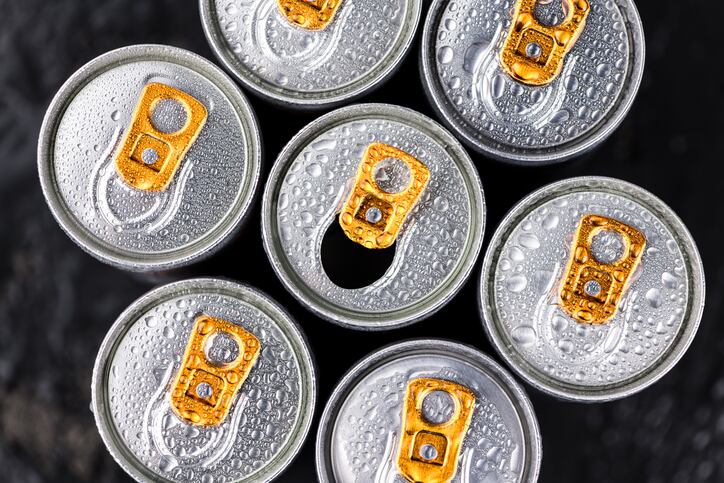They also suggest implementation of educational and awareness programmes, and collaborative risk communication among industry stakeholders, following study results that show adverse effects from current levels of caffeine, taurine, and D-glucuronolactone in EDs.
Approximately 12% of adult Europeans (including 13.3% of ‘young adults’) describe themselves as regular consumers, drinking EDs four to five times a week or more and consuming a mean average volume of four to five litres per month, according to the authors of a study on volume intake and potential risks.
Writing in 'Nutrients', they explain that consumption likely increased during Covid-19 to alleviate stress, boredom, and improve alertness and highlights the urgent need for increased regulation and greater transparency, given recognised safety concerns.
“There is a global growing concern about the potential risks and the existing low-risk perception associated with these drinks. In general, the evidence correlates EDs with a significant increase in the odds of insomnia (and jitteriness/activeness), anxiety, depression, impulsivity, and poor academic performance, among others,” they say.
Labelling is also inadequate and often completely excludes taurine and D-glucuronolactone (as well as other compounds that may exert negative effects) from ingredient lists, they assert.
Health risks
Caffeine can affect cardiovascular, haematological, neurological, and psycho-behavioural mechanisms, provoke sleep onset latency, and cause sleep deprivation. It is also known to induce moderate physical dependency and tolerance, the authors say.
Current ED concentrations range from 15 and 55 mg per 100 millilitres (mL), and average 32 mg/100 mL, although the three standard (commercial) volumes are 250 ml, 333 ml, and 500 ml. European Food Standard Agency (EFSA) safety guidelines suggest no more than 400 mg daily per 70kg body weight (b.w.).
On the other hand, standard ED levels for D-glucuronolactone and taurine are 2,400 mg and 4,000 mg per litre, respectively. The no-observed-effect level (NOAEL) for D-glucuronolactone intake is currently 1,000 mg per kilogram body b.w. daily, while taurine is broadly considered safe at daily reference levels of 1,400mg per 70kg b.w.
The authors assert that although dietary exposure to D-glucuronolactone is generally low (1/2 mg/day), over-consumption has been linked to unspecified renal lesions in rats and raised concerns about safety.
Furthermore, while taurine helps modulate neurological activity and has antioxidant and anti-inflammatory properties, an excess can affect cognitive and behavioural activity in young adults. In addition, supplementation is not advised in healthy individuals due to the low risk from acute oral toxicity, while experts are also concerned by the progressive increase in concentrations since products were first commercialised.
Protocol
Dietary exposure of three consumer profiles based on body weight (40, 60, and 80 kgs) and three standard ED volumes were evaluated. EDs contained standard levels of caffeine (32mg/100ml), taurine (4,000mg/L), and D-glucuronolactone (2,400mg/L).
Health risks from exposure to caffeine and taurine were performed by assessing estimated daily intake (EDI) with established reference intake levels and known adverse effects.
D-glucuronolactone risk characterisation was determined by calculating the margin of safety (MOS) using the NOAEL and EDI.
High caffeine intake
Caffeine EDI varied from 80 mg per 250 ml volume and 160 mg with 500 ml. This is higher than previous reports that note daily intake of 22.4 mg for adult EU consumers and 48.3 mg for high chronic users, for example, the authors explain.
Results suggest that consumers with a body weight of 40 kg are at risk from sleep disorders with consumption equal to or higher than 250 ml and sleep disturbances, as well as general adverse health effects, with daily 500 ml intake.
Equally, individuals weighing 60 kg were more likely to suffer from sleep disorders with intake higher than 250 ml, although the authors note that intake below 500 ml did not affect overall adverse health effects. In addition, sleep disturbances may be avoided by limiting intake to 333 ml for those weighing 80 kg, and none of the scenarios affected general health in this demographic.
Risk characterisation
Findings for D-glucuronolactone also revealed higher intake compared to previous studies on EU consumers, but risk characterisation indicated high ED consumption (up to 500 ml) reduced MOS.
“Results do not support the EFSA statement based on the NOAEL established for the toxicological effects of D-glucuronolactone (1000 mg/kg b.w./day) which reported that dietary exposures at the levels present in EDs are not a health concern for a person of a 60 kg body weight, even when the chronic consumption of EDs is high (350 mL/day),” the authors write.
Nevertheless, they maintain health risks from any exposure to D-glucuronolactone would be expected for those with low body weight (around 40kg).
Communication measures
Finally, intake estimates for taurine were five times higher that reported by the EFSA for adults in 2013 and was attributed to increased concentrations in product formulas.
Therefore, consumption of 500 ml (that contains 2,000 mg of taurine) exceeds the reference intake for individuals with a 40 kg body weight, “posing a health risk that may require management and communication measures” and exposes heavier consumers (80 kg) to associated health risks, the authors say.
“It is undoubtedly necessary to advance in the establishment of a legal framework for EDs in Europe that includes the setting of maximum contents of active ingredients, to monitor the dietary exposures to all the active components and not exclusively caffeine and to improve the information to consumers,” they conclude.
Source: Nutrients
Published online, December 1, 2022: http://doi.org/10.3390/nu14235103
‘Caffeine, D-glucuronolactone and Taurine Content in Energy Drinks: Exposure and Risk Assessment’
Authors: Carmen Rubio, Montaña Cámara, Rosa María Giner, María José González-Muñoz, Esther López-García, Francisco J. Morales, M. Victoria Moreno-Arribas, María P. Portillo and Elena Bethencourt

